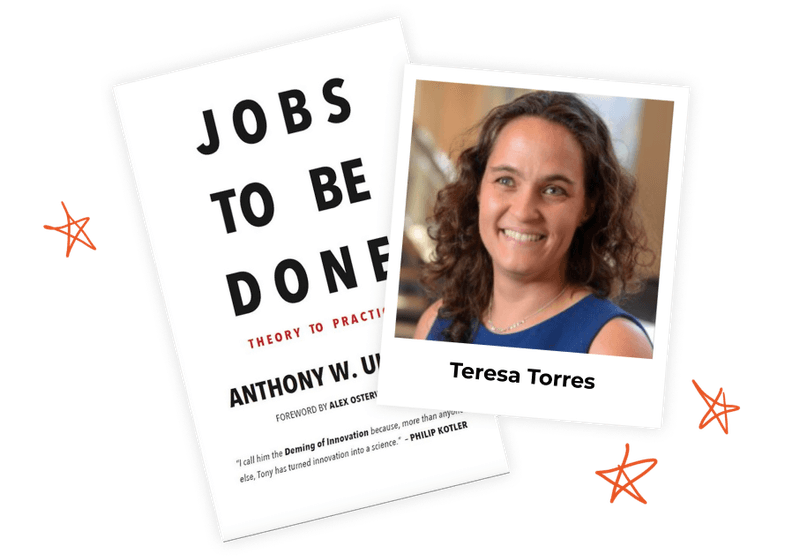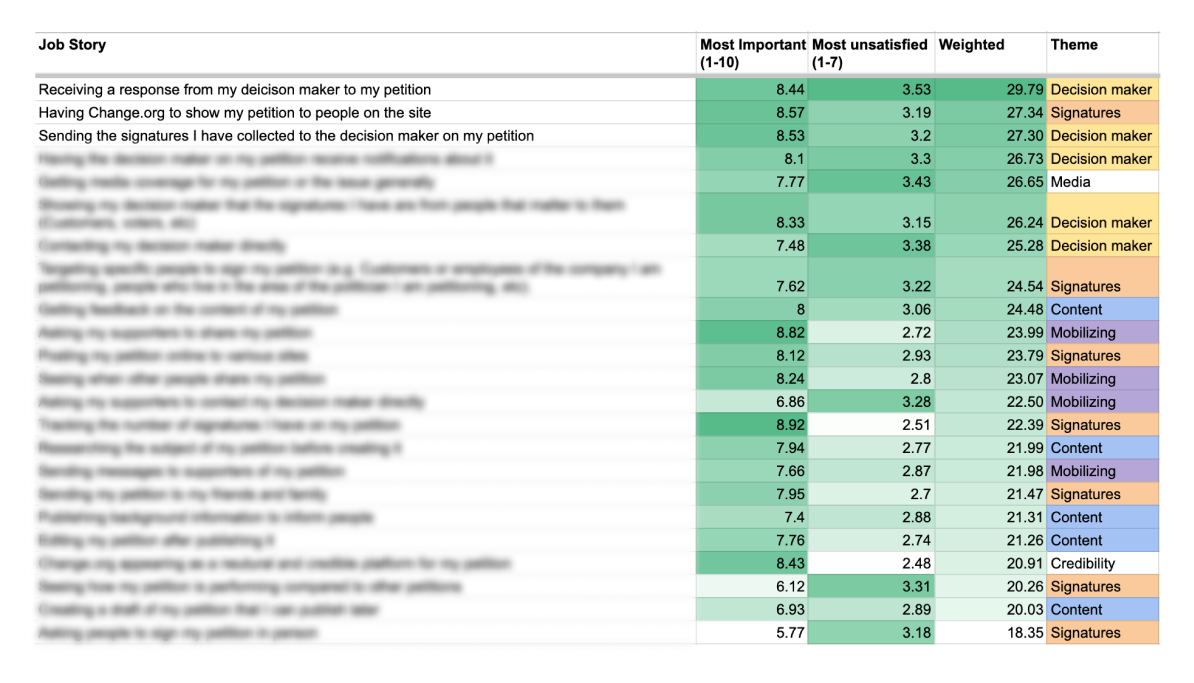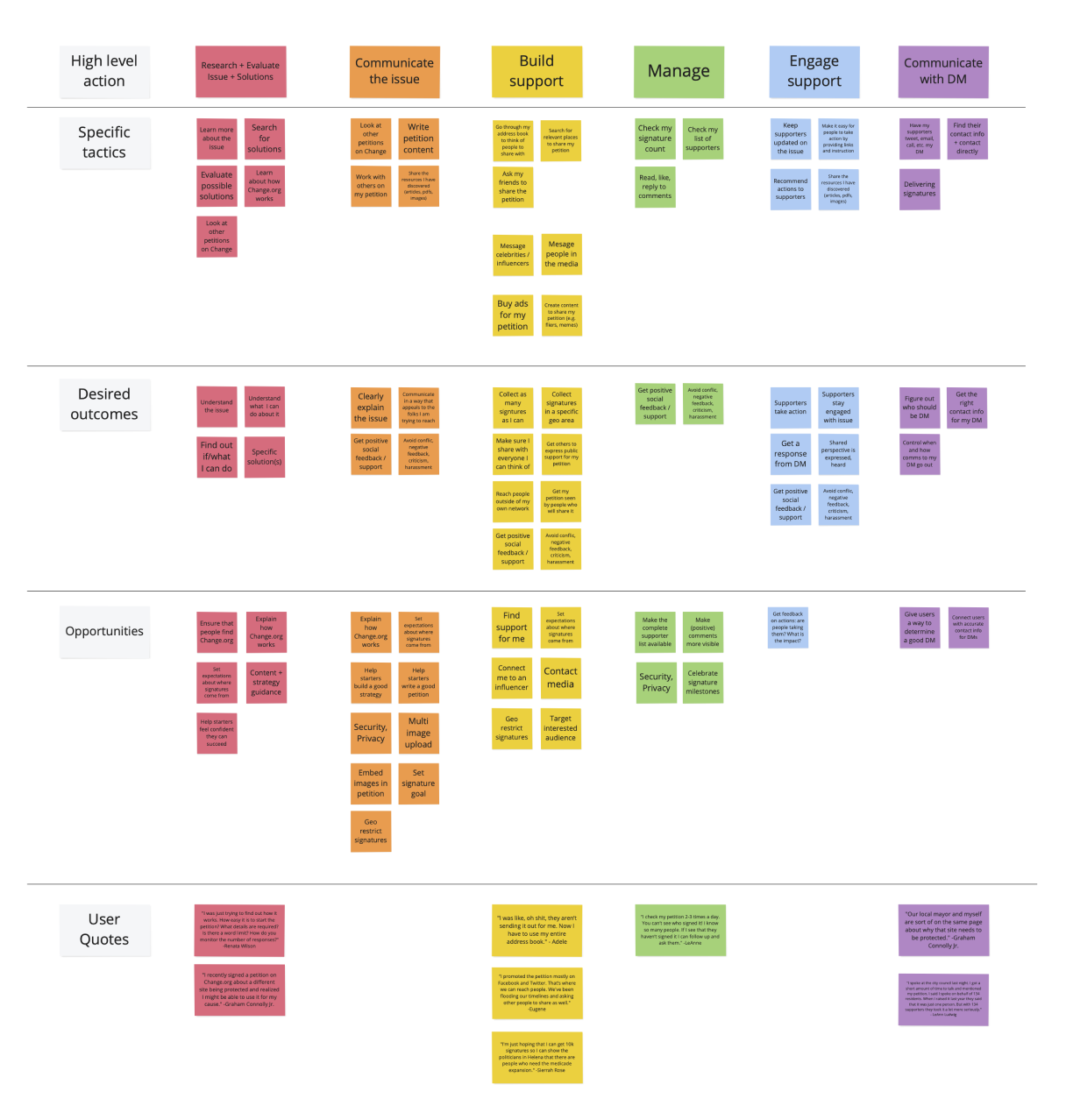The Change.org Petition Starters Team sought to better understand their users and their met and unmet needs. Despite conducting weekly user interviews, the team wasn’t getting actionable or novel insights and didn’t have a shared story about who they were serving.
One of the first things I did was change the interview targeting and ditch the existing scripts. I leveraged Jobs to Be Done to rewrite our interview scripts and re-frame our thinking about user needs by creating job stories.
When my product partner introduced Teresa Torres' framework, Continuous Discovery, we continued our research with weekly petition starter interviews. Adopting processes like opportunity mapping to help us organize, validate, and prioritize the opportunities we uncovered from this work.
By leveraging these frameworks, I was able to bring in an expert design opinion that bolstered and supported the design team's voice. It also helped reduce the workload for our small design team (just 3 people!) by helping us to empower our product teammates to do quality research.

I conducted interviews with a dozen petition starters on our platform and encouraged my product and engineering teammates to attend or otherwise listen to the recordings or read the note summaries. Through collective participation in the work, we developed a shared story about who our users were and what their needs were. We were also able to gather more insights and have interesting and useful conversations as a team about what we were learning!
After we established an initial set of user profiles using the Jobs to Be Done framework, we continued to build on our understanding with weekly interviews with petition starters, using tools from Continuous Discovery.

Through the initial set of interviews, we uncovered two high-level 'jobs' that our users were hiring Change for – these also helped to inform our early user profile clusters.
Other insights jumped out as well. Folks who had the Organizer job tended to have petitions based on local, community issues and demonstrated heightened engagement and success. They were were currently the best served by our existing product. Their greatest unmet needs were around our Decision Maker tools and signature collection – these folks really wanted to be able to limit their signatures to a geographic area and show their decision maker that these folks came from their community.
Meanwhile, Amplifiers often expected that Change.org would connect them with an audience, and were frequently disappointed and discouraged when their petitions failed to gather any signatures. This highlighted an opportunity for us to either meet that expectation, or better manage it upfront.
Once these high level needs had been identified, we continued our user interviews under the Continuous Discovery model. Over time, the patterns between our users became clearer and clearer, and I was able to continue to build on these early profiles. Organizers and Amplifiers evolved into four distinct user profiles, shown below.
These folks are working on an issue that impacts their local community, or a smaller community they belong to – like a school or club. They are very likely to have a specific signature goal based on a specific decision maker for their petition, and this person tends to be accessible.
Connection to the issue

Theory of change

Community support


Adeline
Save Ponderosa Park from Privatization
Public Spaces and Facilities

Marienne
More options for learning through Covid
Parents and Students

Tara
Preserve our University's only vegan food club
Organizations and Clubs
These folks are seeking justice or aid on behalf of someone else – often a friend or family member. The stronger the personal connection, the more likely the starter is to stick with their petition and continue to develop their strategy and build support.
Connection to the issue

Theory of change

Community support


Anette
Free my illegally incarcerated husband
Justice for an individual or family

Judith
Justice for child killed in bullying incident
Justice for a member of the community
These petitions are sparked by an event - like a national or local tragedy, or a trending issue, like the removal of confederate statues throughout the US. Typically, a wave of community support for the issue inspires the petition starter.
Connection to the issue

Theory of change

Community support


Linda
Prevent children from dying in hot cars
Public Safety, Recent Events

Mike
Save the USPS
News, National Movements

Shayna
Stop Hedge Funds Manipulating Stock Price
News, National Movements
Petition starters for these petitions are often just having fun or promoting an idea – though none were entirely unserious. These petition starters still put effort and energy into promoting their petitions.
Connection to the issue

Theory of change

Community support


Adam
Make Adam the next
Bachelor on ABC
Fun with friends

Helen
Knight Ozzy Osbourne
Fan Community
In addition to the user profiles I developed, this research also uncovered many unmet user needs that represented valuable opportunities for our team and others to pursue. In order to further validate and prioritize these opportunities, we needed some more data, specially gathering quantitative data would help us understand the overall opportunities and space.
I collaborated with my product partner and engineering teammates to identify which needs we’d heard most frequently in sessions or had heard as the most painful to our users. After synthesizing the insights into job stories, my product partner and I formatted them into a survey in order to calculate opportunity scores for each of them.

We were able to gather hundreds of responses that helped us to validate several key opportunities by calculating opportunity scores. We were also able to expand the survey and translate it into Portuguese, Spanish, and French, to gather data for other locales and languages.

In the end, we had gathered numerous opportunities we could have confidence going after, and we gained a shared story of who our users were and a renewed passion for serving them. We'd also learned two new frameworks together, strengthened our team process and work, and could show it off to the rest of the organization to help level-up our product strategy and research processes. 🎉As a result of this work, the Change.org data team was tasked with digging into metrics surrounding our Community / Local Organizers. They found that starters who fit this profile were 3x more likely to achieve a petition victory. This insight had organization-wide impact on our strategy and company vision.
